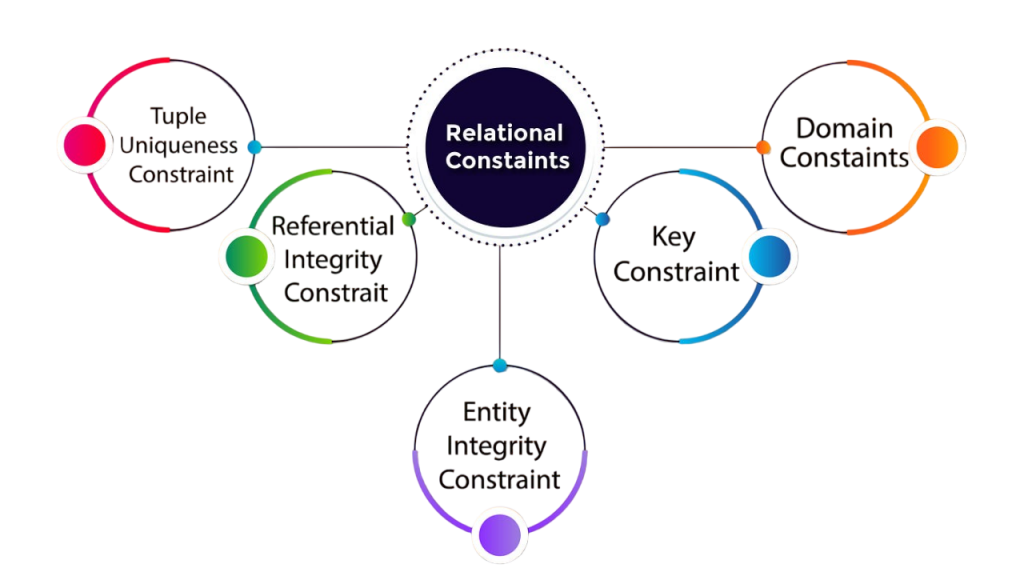
- SQL Constraints Introduction
- What Are SQL Constraints?
- Importance of SQL Constraints
- Types of SQL Constraints
- Performance Considerations of Constraints in SQL
- Errors and Troubleshooting in SQL Constraints
- Conclusion
SQL Constraints Introduction
SQL constraints are rules applied to table columns to ensure the accuracy, consistency, and reliability of the data stored in a relational database. They act as safeguards to prevent invalid data from entering the system and help maintain the integrity of the database principles reinforced in Database Training, where learners gain hands-on experience with constraints, validation rules, and schema design. By mastering these safeguards, developers ensure that data remains accurate, consistent, and secure across all stages of application development and deployment. Constraints are defined during the creation of a table or can be added later using the ALTER TABLE statement. Common types of SQL constraints include NOT NULL (ensures a column cannot have a NULL value), UNIQUE (ensures all values in a column are distinct), PRIMARY KEY (uniquely identifies each record in a table), FOREIGN KEY (enforces a relationship between tables), CHECK (validates data based on a logical condition), and DEFAULT (provides a default value for a column when none is specified).
Do You Want to Learn More About Database? Get Info From Our Database Online Training Today!
What Are SQL Constraints?
SQL constraints are rules that limit users from entering specific types of data into table columns. These rules apply at the database level, meaning that you cannot insert or update data that does not follow the policies. Following SQL constraints reduces the chance of errors and inconsistencies core practices emphasized in Start a Career in Database Administration, where learners build foundational skills in relational modeling, data validation, and DBMS integrity enforcement. Mastering constraint logic is essential for aspiring DBAs who aim to maintain clean, reliable, and secure data environments across enterprise systems.
Importance of SQL Constraints
SQL constraints are essential rules that developers or users must follow. Without these constraints, data can become inconsistent, leading to potential integrity issues and data duplication. For example, if users share the same phone number, the unique identifier constraint ensures that it isn’t repeated principles emphasized in Become a Data Modeler, where learners explore how structured modeling, entity relationships, and constraint logic form the backbone of reliable database design. Mastering these rules is critical for building scalable systems that preserve data accuracy and enforce business rules.

Major Significance of SQL Constraints:
- It creates a relationship between the tables in a database
- It maintains consistency within the tables
- It prevents NULL values and duplicates
- It has predefined rules for the tables
Types of SQL Constraints
NOT NULL Constraint in SQL
The NOT NULL constraint prevents NULL values in a column. If applied, every row must contain a non-empty value a rule that supports data integrity within a Transaction Processing System, where consistent and reliable input validation is critical. TPS frameworks rely on constraints like NOT NULL to ensure atomicity and consistency, enabling predictable behavior across real-time operations and multi-user environments.
Why Use NOT NULL?
- To ensure that every item has a value in the table
- Guarantees all variables have values to avoid third-party interference
UNIQUE Constraint in SQL
The UNIQUE constraint ensures no duplicate values exist in the constrained column(s) a foundational rule emphasized in Database Training, where learners explore key database constraints, normalization techniques, and schema design. By enforcing uniqueness at the column level, developers maintain data integrity and prevent redundancy across relational database systems..
Why Use UNIQUE?
- Prevents duplicate values in rows
- Maintains data integrity for fields like phone numbers, employee IDs, usernames
- Simplifies data search with unique identifiers
- Reduces bugs caused by duplicate entries

PRIMARY KEY Constraint in SQL
The PRIMARY KEY uniquely identifies each record in a table. It implicitly enforces NOT NULL and UNIQUE constraints.
Why Use PRIMARY KEY?
- Uniquely identifies each record
- Prevents duplicate primary key values
- Disallows empty values
- Supports foreign key relationships for table linkage
FOREIGN KEY Constraint in SQL
The FOREIGN KEY creates a relationship between tables by referencing the PRIMARY KEY of another table.
Why Use FOREIGN KEY?
- Maintains integrity and consistency across tables
- Prevents invalid data insertion without matching primary key
- Flags errors during INSERT or UPDATE if parent record is missing
CHECK Constraint in SQL
The CHECK constraint enforces specific conditions on column values. Available in MySQL 8.0.16 and later.
Types:
- Inline constraint
- Table-level constraint
Why Use CHECK?
- Establishes rules within the database
- Validates values before execution
- Preserves data consistency
DEFAULT Constraint in SQL
The DEFAULT constraint assigns a predefined value when none is specified during INSERT a rule that supports efficient data handling and reduces manual input errors, as highlighted in SQL Optimization Techniques. Leveraging default values can streamline insert operations, minimize NULL-related exceptions, and improve query performance by reducing conditional logic in application code.
Why Use DEFAULT?
- Maintains consistency with fallback values
- Reduces manual updates by auto-filling fields
- Minimizes NULL values in columns
To Earn Your Database Certification, Gain Insights From Leading Blockchain Experts And Advance Your Career With ACTE’s Database Online Training Today!
Performance Considerations of Constraints in SQL
Constraints in SQL, including PRIMARY KEY, FOREIGN KEY, UNIQUE, CHECK, and NOT NULL, play a key role in maintaining data integrity and enforcing business rules. However, they can also impact the performance of SQL operations, especially in high-transaction settings. For example, PRIMARY KEY and UNIQUE constraints automatically create indexes, which may speed up search operations but add overhead to INSERT and UPDATE statements due to the need to maintain index structures. FOREIGN KEY constraints require checking referenced values in the parent table during data manipulation, which can slow down performance if proper indexes are absent. Similarly, CHECK constraints evaluate logical conditions for each row, potentially adding processing time during inserts and updates validation logic that aligns with principles covered in What is Data Modelling, where learners explore how rules, relationships, and constraints shape the structure and behavior of database systems. By integrating CHECK constraints into a well-designed data model, developers ensure that business logic is enforced consistently at the schema level. While constraints are crucial for ensuring data accuracy, excessive or improperly defined constraints can lead to performance issues. Developers must balance the need for data integrity with optimizing performance, often by selectively applying constraints and ensuring that supporting indexes exist for efficient execution.
Errors and Troubleshooting in SQL Constraints
Primary Key Violation:
- If there is any duplicate primary key constraint in the same database, it will cause an error
- Use a SELECT statement to check whether the primary key exists a fundamental operation in Database Management, where learners explore how DBMS platforms enforce data integrity, manage relational keys, and support efficient query execution.
- Verifying primary key presence ensures uniqueness and prevents duplication, which is critical for maintaining consistent relationships across normalized tables.
- If it does, either delete it or create a different primary key
Foreign Key Violation:
- Occurs when the foreign key does not match the parent table
- Use REFERENCES or a query like ON DELETE SET NULL if needed
Default Constraint Violation:
- Happens when the default values do not apply, or unexpected NULL values appear in the table or row
- Ensure you do not apply NULL values or define DEFAULT constraints in the row
Preparing for a Database Job? Have a Look at Our Blog on Database Interview Questions and Answers To Ace Your Interview!
Conclusion
SQL constraints are crucial tools in databases that help maintain consistency, integrity, and prevent duplicate values in a table. By applying these rules, the database can be improved without errors or declines in query quality. These rules apply at the database level principles reinforced in Database Training, where learners explore normalization techniques, indexing strategies, and query optimization methods. Mastering these foundational rules ensures consistent performance, data integrity, and scalable architecture across enterprise-grade database systems. To establish a clearer and more stable database, you must adhere to all constraint guidelines. In this blog, you have learned about the six types of constraints in SQL, their purpose, and how they function within a database.


